
(Saddle Up or Deflection Shot?)
|
Or how does the bullet get to its target?
|
by Hammer
Download this page as a PDF File formatted for printing Aces High allows you to set the convergence of the guns on the planes you fly. Setting convergence adjusts the trajectory of your guns so the bullet streams come together at the aiming point at the desired range. Before discussing how to set your convergence, you need to understand what happens to your bullets when they are fired, how setting convergence compensates for this, and some things you should consider when setting your convergence.
In Aces High, each weapon's ballistic characteristics are modeled. These run the gamut from the laser-like 20mm Hispano cannon to the anemic Japanese Ho-5. In order to make maximum use of your plane's weapons, you must understand how they perform and make adjustments accordingly. Setting your gun's convergence to range X adjusts two important angles on the guns. It adjusts a horizontal angle so the bullets will cross at range X and adjusts the vertical angle (range) so the bullet will be at the same level as the aim point at range X. This is important because, depending on the ballistics of the weapon you are using, shooting at targets significantly closer or farther away than your convergence setting could be missed because of the compensations made. See the examples below.
While these examples are extreme, they illustrate the things you should consider when setting your convergence and aiming your weapons at ranges other than your convergence range. All shots at less than convergence range will strike higher than the aim point while all shots at more than the convergence range will strike lower than the aim point. If you are in a plane with guns mounted outside on the wings, shots at any more than twice the convergence range have little chance of hitting. Setting Your Convergence
Colored lines extend from each gun and converge at some distance in front of the plane. To change the distance where the weapons converge, move your cursor over the convergence point until the cross-hairs and distance appear in the same color as the lines from the guns you wish to adjust. Once this happens, click on the cross-hair and drag it out or in to the distance you want. Different sets of weapons may be set to different convergence distances. While you will want to experiment and find a range that is comfortable for you, your flying style, and your gunnery skills, a decent range to start out is 300 - 350. You will still want to experiment and adjust for your style of flying. There are a couple of theories on how you should set your convergence. Probably the most common is to set all of your guns at the range which you feel you take most of your shots. Another, used primarily on the 6 or 8 x .50 cal U.S. planes, says to set your pairs at various ranges to give you the biggest spread of bullets and therefore a larger probability of getting some hits. You will have to decide what works best for you. |
by Soda
Open this page as a PDF file formatted for printing Weapons on aircraft are mounted in many locations, often wherever there was space. Designers often modified designs as aircraft grew in size and firepower, weapons being inserted, moved to new locations or upgraded in size/weight. Typically, they come in a couple of different styles, cowl mounted (i.e... on the fuselage) and wing mounted. The main issue at hand though is whenever you have more than one gun though you likely want them all to meet up at some point where they can inflict damage on the same area of an enemy aircraft. Shooting one hole in the enemy aircraft’s tail, one in the wingtip, and another in the opposite landing-gear, isn’t likely to be nearly as successful as putting all 3 rounds into one location.
This made for a nightmare situation where you could have two guns that were 20ft or more apart from each other. Often, like in the Spitfire you’ve been flying, there were not just two weapons that far out, but many, all at different distances from the center of your aircraft (though matched on each wing). There were issues though that influenced the placement, which included the fact that weapons required to fire through the propeller arc. Each plane, because of the layout of the guns, has different convergence issues. There are also all kinds of different opinions on how best to set up convergence, but in my mind there are a couple of reasonable policies you can follow until you find something that you specifically like. Point Convergence vs. Zone ConvergenceJust as the name implies, point convergence is exactly that, setting all guns to pass through a single point at a specific distance. Zone convergence is designed to not have all guns concentrated at a single point, but to spread them out over a small range, applying a zone where lots of bullets are expected to pass. The point convergence tends to favor smaller caliber, or when there are fewer weapons because it focuses the firepower the best. Zone convergence is best when you have more, and more significant, weapons that you can afford to spread over a small zone (usually no more than D100 long). The Point convergence will always give you the best performance at the range point you set, but tend to become noticeably less effective as soon as the ranges strays more than a little bit outside that range. Zone convergence tends to give a bit better blanket coverage over a range. As your skills develop, and depending on how you like to fight, you can adjust your convergence to best suit your style. My personal preference (and reasoning) runs something like this for newer players: - For guns that are cowl mounted, I always set them out to D650, even if I know that I can’t reasonably take shots out that far (because of poor ballistics). - For aircraft with wing mounted weapons, if: The guns are of small caliber (.303 or 7.7mm types) and four or fewer, then I try and give a point convergence. Guns this light are not terribly effective so concentrating them is very important. They also rely heavily on kinetic energy (i.e., they aren’t exploding shells), so setting the convergence point too far out will make them less effective since the bullets tend to lose kinetic energy before too long. Therefore, I tend to set the convergence point to somewhere closer than D350. This takes away an element of long range shooting because by twice the point convergence range the bullets will be passing at the same width apart as when they were fired. If you have eight weapons of the .303 or 7.7mm type, then you can likely afford to make a zone convergence as the pure number of bullets will make up for some of the concentration you lose by not having a point convergence. Again, don’t set the point out terribly far, although you can likely afford to set it further out if the 4 guns are closely spaced on each wing. Example, the Hurricane I has 8 .303’s, 4 in each wing, and they are packed very closely in each wing, giving a natural convergence of those 4 guns as long as they are all lined up in relatively in parallel. The Spitfire I has the same 8 guns, though they are spread out over the length of the wing, necessitating a little more concentration. If I have four .50 or fewer (12.7mm) weapons, I tend to still go for a point convergence, though it can be a little further out (D350-D400), or could be a very small zone (setting the two banks of guns not more than about D50 apart). If you have six or more .50’s, you have to make a decision since you can go either point, or zone. Also consider whether you are going to be strafing, for which a further convergence is better. I tend to place six guns into a zone, though more distant than in the case of .303’s. I tend to place eight guns at a point convergence at D650 since having four weapons in parallel trajectory gives sufficient natural concentration of fire. - For cannons I tend to set them to D650, or if the ballistics are really poor, then at a convergence point slightly longer than what I feel my normal engagement ranges are (D350). Cannons rely on less kinetic energy and more explosive energy, thus you just want to land hits and concentration is slightly less of an issue. These are all just personal preferences though, but it does help me keep a fairly consistent feel between different aircraft so I don’t need to check each aircraft each time I fly it to remember what I set the convergence to. You will find over time though that you can get better performance by matching your convergence to a small zone, or point, at which you find you are typically able to saddle up enemy aircraft (which tends to get shorter with more experience). |
by SodaShooting IssuesWhat most people find when they start the game is that they have difficulty in hitting anything. They often run into a situation where they “spray and pray” simply opening fire and moving their aim point around while hoping to land hits. This simply doesn’t tend to be very effective, nor is it a good use of valuable ammunition (since you really only have a limited amount along with you). This is not unusual though. Initially, you need to understand that there are two types of projectiles that are fired, kinetic and explosive. Kinetic rounds are ones that damage through impact, usually using a solid shot designed to drill into and through and aircraft (often called armour piercing or AP rounds). Explosive rounds (commonly called HE) are ones that are designed to explode, and thus the act of firing them is a process of getting them to the target. Explosive rounds do cause kinetic damage, but their main purpose is to explode and cause damage from that. Now, you do not have a choice of the type of ammunition you take, it is decided based on the type of gun you fire. In general, all weapons that are cannons (20mm and up) fire a mixture of kinetic and explosive rounds, while all smaller caliber guns only fire kinetic rounds. That means, for a US .50 cal (~12.7mm), you have AP ammunition, as do you for British .303’s, or German 7.7mm. Once you reach 20mm, you have a mixed ammunition load, which you cannot control, that includes both AP and HE rounds. The British/US Hispano 20mm, many German weapons from 20mm-30mm all have this mixed ammunition (AP and HE). Obviously, the HE rounds, as described earlier, tend not to be as affected by longer ranges and maintain their damaging power. So, you might think that cannons are the only way to go but that’s simply not the case and it’s not like you have a choice to arm a plane however you might like. Each plane comes with a set number of options that you can chose from, so you have to learn to use what you have. What is the Range of GunsThis question is pretty typical of new players but the answer is not so simple. There are a couple of ways to look at range so it depends on what you are looking for. If you are asking about how far the bullet travels before it has no chance to hit then the answer would be D1.4, or there about. If you are asking how far the average player can actually land an aimed shot at a basically non-maneuvering target, then the range is more like D600, less than 1/2 the maximum range, and that’s in a best case scenario. If you are asking what is a realistic range, then something more in the range of D300 is probable for damaging hits on an enemy who is maneuvering to defend themselves. In general, you should consider anything inside D250 as short range, D250-D400 as medium range, D400-D600 as long range, and anything in excess of that as extreme range, on average. These are somewhat generic numbers though and don’t take into account the complexities involved with aiming and hitting under anything but the best conditions. Differences in maneuvering, speed, gun types, gun positions and convergence settings can all make shots more or less difficult. It is possible to make longer shots though. In prime conditions it can be possible to reliably land hits out to almost D1.0, though these are rare. Some players also resort to spray’n’pray tactics where they have lots of ammunition to throw away hoping for a couple of lucky hits. Most planes don’t have this luxury though and cannot afford to fire where there is little reasonable chance of success. What can I do to help my shooting ability?Most new players will find that they are having aiming problems and spending a lot of time shooting towards a target but not hitting it. There are a couple of things you need to consider in which to improve: 1. Get closer. Pretty simple concept, but most new pilots are trying to shoot at
too long a range. Aiming at D150 is simple, aiming at D400 is more difficult,
and aiming at D900 is almost impossible. There is also a target you can use to see exactly where you should be aiming to account for bullet drop. I wouldn’t recommend this except in offline mode, but when in an airplane, use the .target X command (where X is a range between 0 and 1000). This will display a target to your north (always to the north) at the range you specified. You can then shoot at the target and watch where the hits land. You will notice that no two bullets actually pass through the exact same spot, but you will see concentrations of fire in certain spots. The target will reset after about 1000 hits and you can turn it off by issuing the command and using a range of 0. One other suggestion and this is made for a number of reasons, is stay with a single aircraft for a while. Learn that one plane, how it handles, and where to aim with it. Don’t immediately jump from plane to plane looking for the guns that best suit you, look to learn how to use the guns. The Spitfire V that you are currently flying offers a nice starting point for you to learn. The twin hispano 20mm cannons it has are the best cannons in the game and easiest to aim. The .303’s are a perfect example of convergence issues since they are widespread on the wings. If you get the convergence set properly, they can still be effective. Then, if you want to move up, the Spitfire Mk IX offers the same hispano cannons, and an option to replace the four .303’s with a pair of US .50’s. The change tends to add easier aiming as the .50’s are the best you can get in the game at all ranges, but there are only a pair of them vs. the four .303’s you replaced. Custom GunsightsThere are links on the Aces High website to historically accurate, and custom, gunsights. The process to replace a gunsight is very easy, simply download it, copy it into the directory /gunsights and then in setup, open up the gunsight selection screen. From there, simply select the plane and assign the gunsight to it. Some gunsights have markings to help judge distances, though largely this is unnecessary considering that all aircraft in the game will display an exact range with their icon. There are sights that have some deflection aiding components that can be useful though deflection shooting is as much art as science. Some sights also have markings to help you aim rockets, or bombs, or you may decide to create one yourself. |
Flight Instruction
Courtesy of Zeno's Warbird Videos


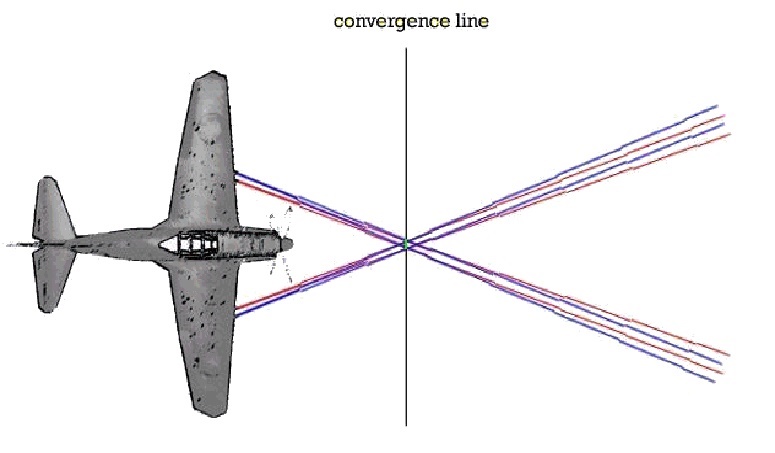
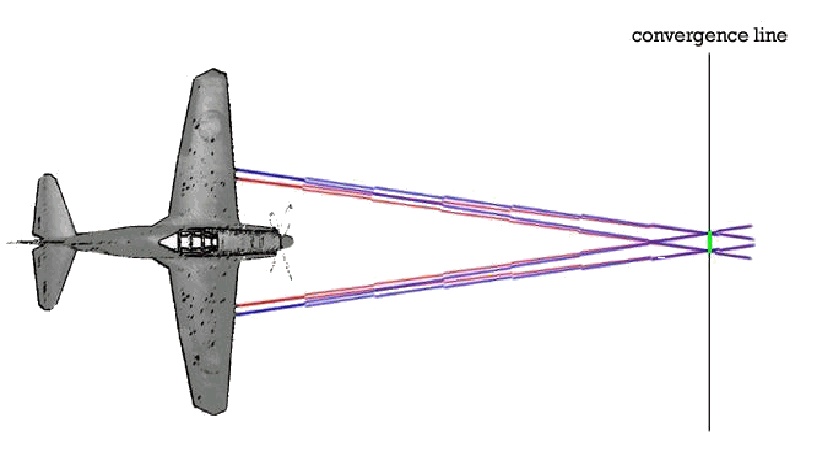
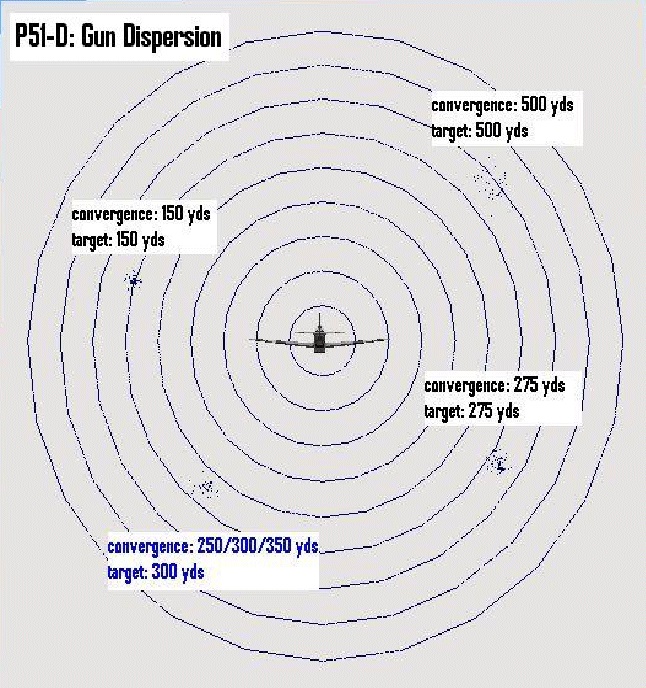
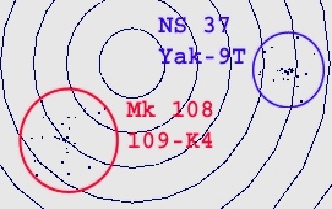 Dispersion
of the rounds is also a characteristic of the gun type. There are
guns that have a higher dispersion (Mk 108 on a 109-K4) and some that
concentrate bullets better (NS 37 on a Yak-9T), both being high caliber cannons,
shots fired at same distance from target.
Dispersion
of the rounds is also a characteristic of the gun type. There are
guns that have a higher dispersion (Mk 108 on a 109-K4) and some that
concentrate bullets better (NS 37 on a Yak-9T), both being high caliber cannons,
shots fired at same distance from target. 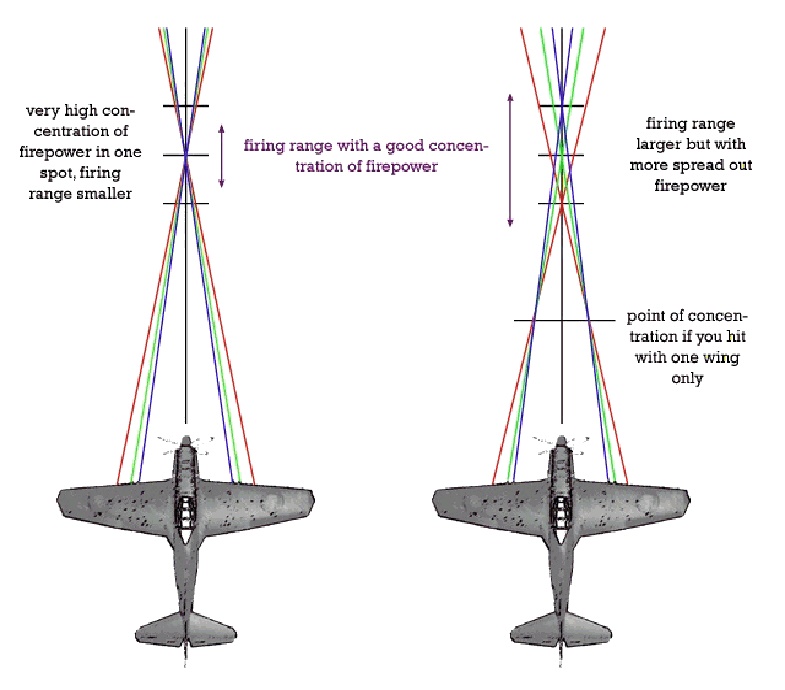
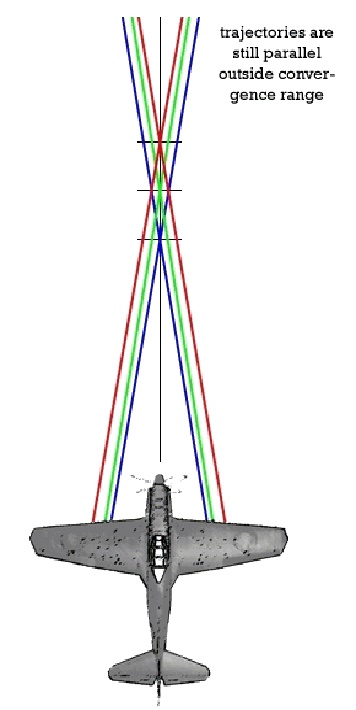 The
other option is to have the outside gun set furthest like on the plane to
the right. This will not result in this second converging point, but advantage of
that setting is that the bullet trajectories of the guns stay parallel for
basically the whole guns range – as opposed to the above setting, where outside
optimum firing range, the guns start to spread out. When bullet concentration
isn’t all that important (for example in cannon armed planes) and you find
yourself taking shots over a very wide range of distances, this is a good
setting to try.
The
other option is to have the outside gun set furthest like on the plane to
the right. This will not result in this second converging point, but advantage of
that setting is that the bullet trajectories of the guns stay parallel for
basically the whole guns range – as opposed to the above setting, where outside
optimum firing range, the guns start to spread out. When bullet concentration
isn’t all that important (for example in cannon armed planes) and you find
yourself taking shots over a very wide range of distances, this is a good
setting to try. As soon as a projectile leaves the end
of a weapon's barrel, it begins to fall. They all fall at the same rate regardless
of which weapon they were fired from. A projectile fired from a level barreled
Hispano cannon will hit the ground at exactly the same time as a rock dropped from
the same level (assuming flat ground!) (actually, many projectiles tend to rise
when they first leave the barrel of a weapon because of the spin put on them. this
is not important for this discussion). The only variable between weapons is how far
the round will travel in that amount of time. This is determined by numerous
factors but mainly by muzzle velocity and the drag of the round, which causes it to
slow. The sum of all these factors is known as the weapons ballistic characteristics,
or ballistics for short. This is important because you must compensate for the
ballistics in order to hit your target at various ranges.
As soon as a projectile leaves the end
of a weapon's barrel, it begins to fall. They all fall at the same rate regardless
of which weapon they were fired from. A projectile fired from a level barreled
Hispano cannon will hit the ground at exactly the same time as a rock dropped from
the same level (assuming flat ground!) (actually, many projectiles tend to rise
when they first leave the barrel of a weapon because of the spin put on them. this
is not important for this discussion). The only variable between weapons is how far
the round will travel in that amount of time. This is determined by numerous
factors but mainly by muzzle velocity and the drag of the round, which causes it to
slow. The sum of all these factors is known as the weapons ballistic characteristics,
or ballistics for short. This is important because you must compensate for the
ballistics in order to hit your target at various ranges. 

 The mechanics of
setting your convergence in Aces High are very easy. It is done
from the hangar by clicking on the "Set Convergence" button. This changes your
point-of-view to the rear of the plane looking forward. Once this is done, you
will want to once again put your clipboard away by clicking on the <ESC> key.
This will give you the view shown here:
The mechanics of
setting your convergence in Aces High are very easy. It is done
from the hangar by clicking on the "Set Convergence" button. This changes your
point-of-view to the rear of the plane looking forward. Once this is done, you
will want to once again put your clipboard away by clicking on the <ESC> key.
This will give you the view shown here: 

 Cowl
mounted weapons would include anything that exists within the main part of
the fuselage of your aircraft. It would include weapons that are on the upper
deck above the engine (such as in the 109 or Zero). It also includes some
aircraft which had a gun actually shoot through the center of the propeller
(Yak9 or 109). Some aircraft, like the P-38 and Bf-110, had engines on pylons to
the sides so the whole nose area could be filled with guns. Convergence of cowl
mounted guns is not really an issue considering that the average nose of a plane
was only 2-3 feet across and any package of guns in that space would place a lot
of bullets close together naturally. Shown are two example 109's the left one
with only standard cowl weapons, while the right picture has gondolas attached,
an option which introduces convergence issues since the wing guns are mounted
mid-wing.
Cowl
mounted weapons would include anything that exists within the main part of
the fuselage of your aircraft. It would include weapons that are on the upper
deck above the engine (such as in the 109 or Zero). It also includes some
aircraft which had a gun actually shoot through the center of the propeller
(Yak9 or 109). Some aircraft, like the P-38 and Bf-110, had engines on pylons to
the sides so the whole nose area could be filled with guns. Convergence of cowl
mounted guns is not really an issue considering that the average nose of a plane
was only 2-3 feet across and any package of guns in that space would place a lot
of bullets close together naturally. Shown are two example 109's the left one
with only standard cowl weapons, while the right picture has gondolas attached,
an option which introduces convergence issues since the wing guns are mounted
mid-wing.
 Wing
mounted weapons configurations were much more variable in layout because of
a number of factors. Weapons placed near the fuselage often had problems with
having to fire through the propeller arc. This required those guns to be
synchronized so that they didn’t hit the propeller and thus took a penalty in
their rate of fire. Weapons that were placed outside of the propeller arc had
other issues in terms of the limited space available as you moved out the wing,
the weight of guns/ammunition, and even aiming problems with the flexing of the
wings under load. One of the main issues though was with convergence, as it gets
worse as you mount guns further apart on opposite wings. The left example shows
an Fw190, with a pair of guns in the cowl, a pair shooting through the
propeller, and a set that are mid-wing. The right example shows a Spitfire, with
4 guns in each wing, the outer most are almost near the wing tip, quite a
convergence issue indeed.
Wing
mounted weapons configurations were much more variable in layout because of
a number of factors. Weapons placed near the fuselage often had problems with
having to fire through the propeller arc. This required those guns to be
synchronized so that they didn’t hit the propeller and thus took a penalty in
their rate of fire. Weapons that were placed outside of the propeller arc had
other issues in terms of the limited space available as you moved out the wing,
the weight of guns/ammunition, and even aiming problems with the flexing of the
wings under load. One of the main issues though was with convergence, as it gets
worse as you mount guns further apart on opposite wings. The left example shows
an Fw190, with a pair of guns in the cowl, a pair shooting through the
propeller, and a set that are mid-wing. The right example shows a Spitfire, with
4 guns in each wing, the outer most are almost near the wing tip, quite a
convergence issue indeed.





